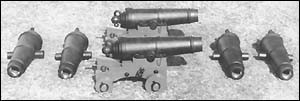Artillery for California Forts

With barrel lengths of 45 inches, weights of 750 pounds, and four inch bores, carronades with trunnions, or “gunnades” await shipment from South Bend, Indiana to the California Department of Parks for incorporation into ongoing restorations at Sutter’s Fort and Fort Ross.
Two California fort restorations moved ahead recently with acquisition of reproduced artillery from South Bend Replicas, Inc., of South Bend, Indiana. The cannons, called “gunnades,” were recently produced on special order for Sutter’s Fort in Sacramento, and Fort Ross, north of San Francisco, under direction of Michael C. Tucker, of the California Department of Parks, which administers both historic sites. Gunnades are a type of early 19th century ordnance closely related to carronades, a type of naval artillery named after the Carron Foundry, in Scotland, where those were originally produced in the late 18th century.
Carronades had no trunnions, and were affixed to specially designed carriages by means of a pin passing through a lug cast into the undersides of the barrels. Conventional guns had trunnions. Gunnades were in the configuration of carronades, but had
trunnions instead of lugs, probably as an accommodation to carpenters and other persons used to working with conventionally mounted guns.
 In the combined period represented by both forts – 1812 to mid-century – it was not uncommon for fort armament to include guns salvaged from ships. California state records hold eyewitness accounts of carronades at Sutter’s Fort and Fort Ross, and surviving originals from Sutter’s Fort have trunnions.
In the combined period represented by both forts – 1812 to mid-century – it was not uncommon for fort armament to include guns salvaged from ships. California state records hold eyewitness accounts of carronades at Sutter’s Fort and Fort Ross, and surviving originals from Sutter’s Fort have trunnions.
At SBR, the guns were produced in 9-pounder (approximately 4-inch) caliber, with muzzles cupped oversize in accordance with original carronade custom, and in barrel weights of about 750 pounds. Consistent with SBR practice and California Park Department requirement, the guns were cast solid, the bored oversize and brought back to caliber with steel bore sleeves.
Carriages for the Sutter’s Fort guns were produced in the SBR shop.
Copies of research material to assist later local construction of the Fort Ross carriages were provided to the curatorial division of the Park Department.
 John Sutter, a German/Swiss entrepreneur who left Europe in 1835 and arrived in California by way of Kansas, Canada, Hawaii, and Alaska, established his fort in 1840 under Mexican citizenship. Between 1841 and 1849, the fort served as a temporary refuge for California settlers including, after a Sutter-dispatched rescue effort, 47 survivors of the tragically
John Sutter, a German/Swiss entrepreneur who left Europe in 1835 and arrived in California by way of Kansas, Canada, Hawaii, and Alaska, established his fort in 1840 under Mexican citizenship. Between 1841 and 1849, the fort served as a temporary refuge for California settlers including, after a Sutter-dispatched rescue effort, 47 survivors of the tragically
fated Donner Party.
Fort Ross was established in 1812 by Russians and native Alaskans to provide crops for Alaska and trade ties with Spanish California.
THEN AND NOW – MAY 1987
